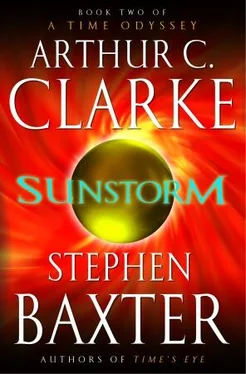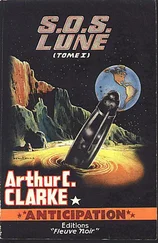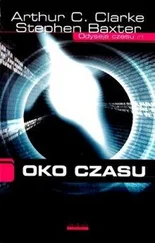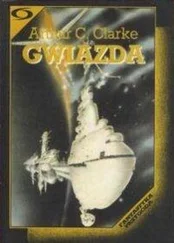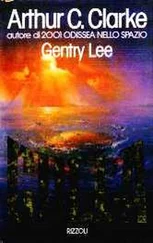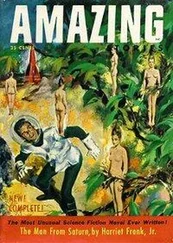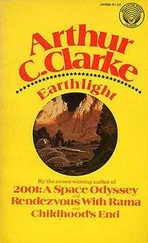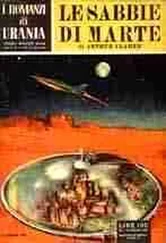“I sympathize,” she said carefully.
He rubbed a chin coated with three days of stubble; he had told her that idiosyncratically he would not shave in space, to save the inconvenience of clippings drifting around the cabin. “Not only that,” he said, “the comms links between the Moon and Earth are notoriously narrow. A bottleneck. If I wanted to prevent sensitive information leaking out onto the global nets, the Moon would be a good place to put it.”
Of course he was right; the ease of securing discussions on the Moon was a prime reason for her journey, rather than bringing lunar-based experts to Earth. She said, “But you know that I’m an envoy of the Eurasian Prime Minister herself. I’m sure you understand that the security restrictions to which I’m subjected come from much higher levels than me.” So don’t probe, she added silently. She turned back to her blank softscreens. “And if you don’t mind—”
“More studying? I think it may be a little late for that.” He glanced out the window.
Her view of the looming crescent Moon was gone, replaced by a mottling of deep black and glowing pale brown that slid past the window.
Mario said softly, “You are looking at Clavius Crater, Professor.”
She stared. Clavius, south of Tycho, was a basin so huge that its floor was convex, pushed out by the curvature of the Moon itself. As the shuttle descended she began to resolve smaller craters on that tremendous floor: craters of all sizes, craters overlapping craters down to the limits of her visibility. It was a strange, ripped-up landscape, like a Great War battlefield perhaps. But there, just emerging from the shadow of the wall, she saw a fine line, a shining thread of gold laid over the Moon’s gray floor. That must be the Sling, the new electromagnetic launch system, still incomplete but already a mighty rail more than a kilometer long. Even from here she could see that human hands had touched the face of the Moon.
Mario was watching her reaction. “It sneaks up on you, doesn’t it?” And he left the cabin to prepare the descent protocols.
Clavius Base was built around three big inflated domes. Connected by transparent walkways and subsurface tunnels, the domes were covered over by Moon dust for protection from the sun, cosmic rays, and other horrors. As a result, seen from above, the domes seemed part of the lunar landscape, as if they had bubbled up out of the gray-brown regolith.
Shuttle Komarov landed without ceremony half a kilometer from the main domes. The dust it kicked up fell back with disconcerting speed onto the airless Moon. There were no pads here, just many shallow blast craters, the scars of multiple landings and takeoffs.
A transparent walkway snaked up to the shuttle’s lock. Escorted by Captain Mario, with her smart suitcase rolling behind her, Siobhan took her first footsteps in the Moon’s dreamy gravity.
Her first glimpse of the Moon, slightly distorted by the walkway’s clear, curving walls, was of a gently rolling surface. Every edge was softened by the ubiquitous dust, the result of eons of meteoritic churning. It looked almost like a snowfield, she thought. The shadows were not the deep black she had imagined, but softened by the reflected glow of the ground. She shouldn’t have been surprised: dark as it was, the light reflected from this lifeless soil was, after all, the Moonlight that had shone over Earth since the great impact that had shaped the twin worlds in the first place. So Siobhan was walking in Moonlight herself. But this bit of the Moon was littered by surface vehicles, fuel tanks, escape bunkers, and equipment dumps; it was a human landscape.
***
The walkway terminated at a small blocky structure. Siobhan and Mario rode the elevator down to an underground tunnel. Here an open cart mounted on a monorail awaited them. The cart was big enough for ten, she realized, the shuttle’s full complement of eight passengers plus two crew, and their baggage.
The cart slid into silent motion.
“An induction drive,” Mario said. “Same principle as the Sling. Endless sunlight and low gravity: the physics behind this little electrical cart might have been invented for the conditions of the Moon.”
The tunnel was narrow, lit by fluorescent tubes, and the fused-rock walls were so close to the cart she could have reached out and touched them—and in perfect safety, for the cart’s speed was little more than walking pace. She was learning that away from Earth, caution ruled: everything was done slowly and deliberately.
At the end of the tunnel was an airlock, and what Mario called a “dustlock,” a small room equipped with brushes, vacuum hoses, and other devices to clean spacesuits and people of electrostatically clinging Moon dust. As Mario and Siobhan hadn’t been exposed to the surface, they were able to cycle through this quickly.
The airlock’s inner door was marked with a large plaque:
*** *** *** ***
WELCOME TO CLAVIUS BASE
U.S. ASTRONAUTICAL ENGINEERING CORPS
She read on down a list of contributing organizations, from NASA and the U.S. Air and Space Force to Boeing and various other private contractors. There was also a rather grudging acknowledgment, she thought, of the Eurasian, Japanese, Pan-Arabian, Pan-African, and other space organizations that had put up more than half the money for this American-led project.
She touched a little roundel that was the logo of the British National Space Agency. In recent years the British had discovered a genius for robotics and miniaturization, and the machine-dominated period of renewed lunar and Martian exploration earlier in the century had been the glory days of the BNSA and its engineers. But that period had been brief, and was already over.
Mario caught her eye and grinned. “That’s the Americans for you. Never give anybody else credit.”
“But they were here first,” she pointed out.
“Oh, yes, there is that.”
The inner door slid open to reveal a short, stocky man waiting for her. “Professor McGorran? Welcome to the Moon.” She recognized him immediately. This was Colonel Burton Tooke, USASF, commander of Clavius Base. Aged about fifty, with a severe military crew cut, he was a good head shorter than she was, and he flashed a disarming gap-toothed grin. “Call me Bud,” he said.
Siobhan said goodbye to Mario, who was returning to his shuttle, “where the beds are softer than anything in Clavius,” he claimed.
Bud Tooke led Siobhan up a flight of stairs, easily negotiated in one-sixth gravity, to the interior of a dome. They walked along a narrow roofless corridor. She could see the dome’s smooth plastic some meters above her head, but the space beneath was cluttered with walkways and partitions. Everything was quiet, the lights subdued; nobody was moving, save Bud and Siobhan.
She said softly, “It seems rather appropriate to arrive somewhere as mysterious as the Moon in silence and twilight.”
He nodded. “Sure. You’ll soon be over the Moon-lag, I hope. It’s actually two A.M.here. The middle of our night.”
“Moon time?”
“Houston time.”
She learned this was a tradition dating back to the days of the earliest astronauts, who had timed their epic journeys by the clocks of their homes in Texas; it was a pleasing tribute to those pioneers.
They reached a row of closed doors. Above, a small neon sign glowed pink: it read CONTACT LIGHT. Bud opened a door at random to reveal a small room, and Siobhan looked inside. There was a bed that could be folded out to become double, a table, chair, and basic comms equipment, and even a small unit containing a shower and lavatory.
“Not quite a hotel. And there’s no room service to speak of.” Bud said this cautiously. Perhaps some VIP visitors threw tantrums at this point, demanding the five-star luxury they were used to.
Читать дальше
